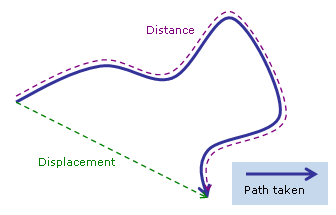Distance
The distance between two points is the length of a straight
line segment between them. In the case of two locations on
Earth, usually the
distance along the surface is meant: either "as the crow flies" (along a great
circle) or by road, railroad, etc. Distance is sometimes expressed in terms of
the time to cover it, for example walking or by car (see
distance covered). Sometimes a distance thus
indicated is ambiguous because the means of transport is neither mentioned nor
obvious.
Distance as mentioned above is sometimes not symmetric, hence not a metric
(see below): this applies to distance by car in the case of one-way streets, and
also in the case the distance is expressed in terms of the time to cover it (a
road may be more crowded in one direction than in the other, for a ship upstream
and downstream makes a difference).
As opposed to a position coordinate, a distance can not be negative. Distance
is a scalar quantity, containing only a magnitude, whereas displacement is an
equivalent vector quantity containing both magnitude and direction.
The distance covered by a person, vehicle (often recorded by a
odometer), animal, object, etc. should be distinguished from the distance from
starting point to end point, even if latter is taken to mean e.g. the shortest
distance, because a detour could be made, and the end point can even coincide
with the starting point.

See also